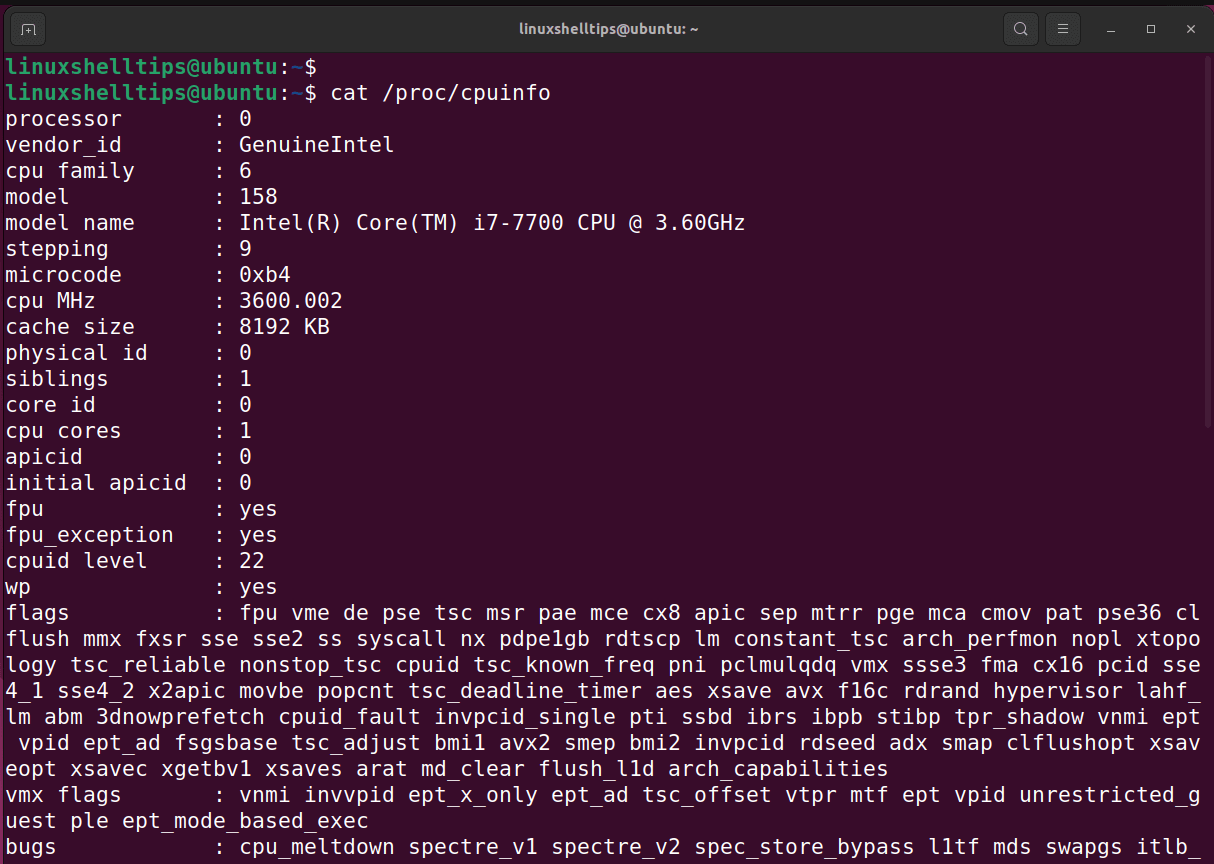The /proc/cpuinfo file is a plain-text read-only file that contains information about the CPU, and displays a wealth of information about the CPU including the vendor ID, CPU family, and model name among other intricate details.
Below is a sample output of /proc/cpuinfo file.
$ cat /proc/cpuinfo
Evidently, the output contains a myriad of flags in the ‘flags‘ section which define the number of various processor attributes.
In this guide, we will shed light on some of the most important flags and understand what information they provide.

1. Lm Flag
The lm flag refers to Long Mode, which proves that the CPU supports 64-bit architecture. This essentially implies that any x86-64 CPU will bear this flag. Conversely, any 32-bit CPU will not have this flag.
2. vmx and svm
The vmx flag stands for Virtual Machine Extension. This is a virtualization extension for the Intel CPU Processor. On the other hand, svm (Secure Virtual Machine ) is the virtualization extension for AMD CPUs.
The presence of any of these flags indicates that Virtualization has been enabled on your PC or virtual machine and that you can install a hypervisor such as KVM, or VirtualBox to create virtual machines.
3. Hypervisor
The hypervisor flag proves that the CPU provides hardware support for running virtual machines. You can achieve this using popular hypervisors such as VirtualBox and VMWare.
4. smx
The smx (Safer Mode Extensions) flag appears on 64-bit processors. It’s an API that enforces security policies in Intel TXT platforms. For instance, it restricts access to specific memory locations or blocks the execution of code from certain sources.
5. pae
PAE, short for Physical Address Extension is a feature that permits CPUs to access RAM sizes greater than 4GB. It’s without a doubt a flag that features in modern operating systems given that a majority of them support huge RAM sizes based on the motherboard of the system.
6. sse
The sse flag (Streaming SIMD Extension) is an extension that is unique to Intel-based processors. It boosts the performance of a system via parallel processing. It comes in handy in process-intensive applications such as gaming, video and photo editing, 3D animation, and so on.
7. sse2
This is basically an enhanced version of SSE. Unlike, the SSE2 has additional instructions and handles 64-bit values. In addition, it can simultaneously perform a single task across multiple pieces of data con.
8. sse3
sse3 is also referred to as the Prescott New Instructions (PNI). It provides 13 new instructions and enhanced performance for 3D tasks and digital signal processing.
9. apic
APIC is short for Advanced Programmable Interrupt Controller. It is a family of interrupt controllers that was developed by Intel and has been around since Intel Pentium. It enables the CPU to handle a large number of interrupts and by so doing, enhances dual processing and multi-processor support.
10. ht
The ht flag is short for hyperthreading. This a feature that enhances the performance and efficiency of a system by allowing the CPU core to execute multiple threads in parallel.
11. tm
The tm flag is an abbreviation for Thermal Cooling. This feature, as the name suggests, regulates the CPU temperature and keeps it at an optimal value by reducing its clock speed. By doing so, it prevents overheating which can cause damage to the CPU.
12. acpi
The acpi flag stands for Advanced Configuration and Power Interface. This is an open standard originally developed by Microsoft, Intel,, and Toshiba. It was tailored to enable operating systems to discover and configure hardware components.
For example, it abstracts the hardware layer and carries out basic power management tasks of devices attached to the system.
13. sse4_1 and sse4_2
sse4_1 and sse4_2 flags are an indicator that your CPU supports Streaming SIMD Extensions 4.1 and 4.2 respectively. These provide support for fast multimedia applications.
Common AMD-Defined Flags
The following are some of the common AMD flags.
- lm: This is an abbreviation for Lockless Multithreading. It enables the running of multiple threads on a single CPU core.
- fma: This stands for Floating Point Multiply Add. This is a floating point operation that combines multiplication and addition into a single instruction.
- abm: ABM is an acronym for Address Based Mapping. It helps map virtual addresses to physical addresses.
- sse4a: This stands for Streaming SIMD Extension 4.0. Like the
ssefamily in Intel, it enhances performance for heavy applications such as 3D animation, video processing, etc.
Conclusion
There you go. We have covered some of the most common and salient flags in the /proc/cpuinfo file.
